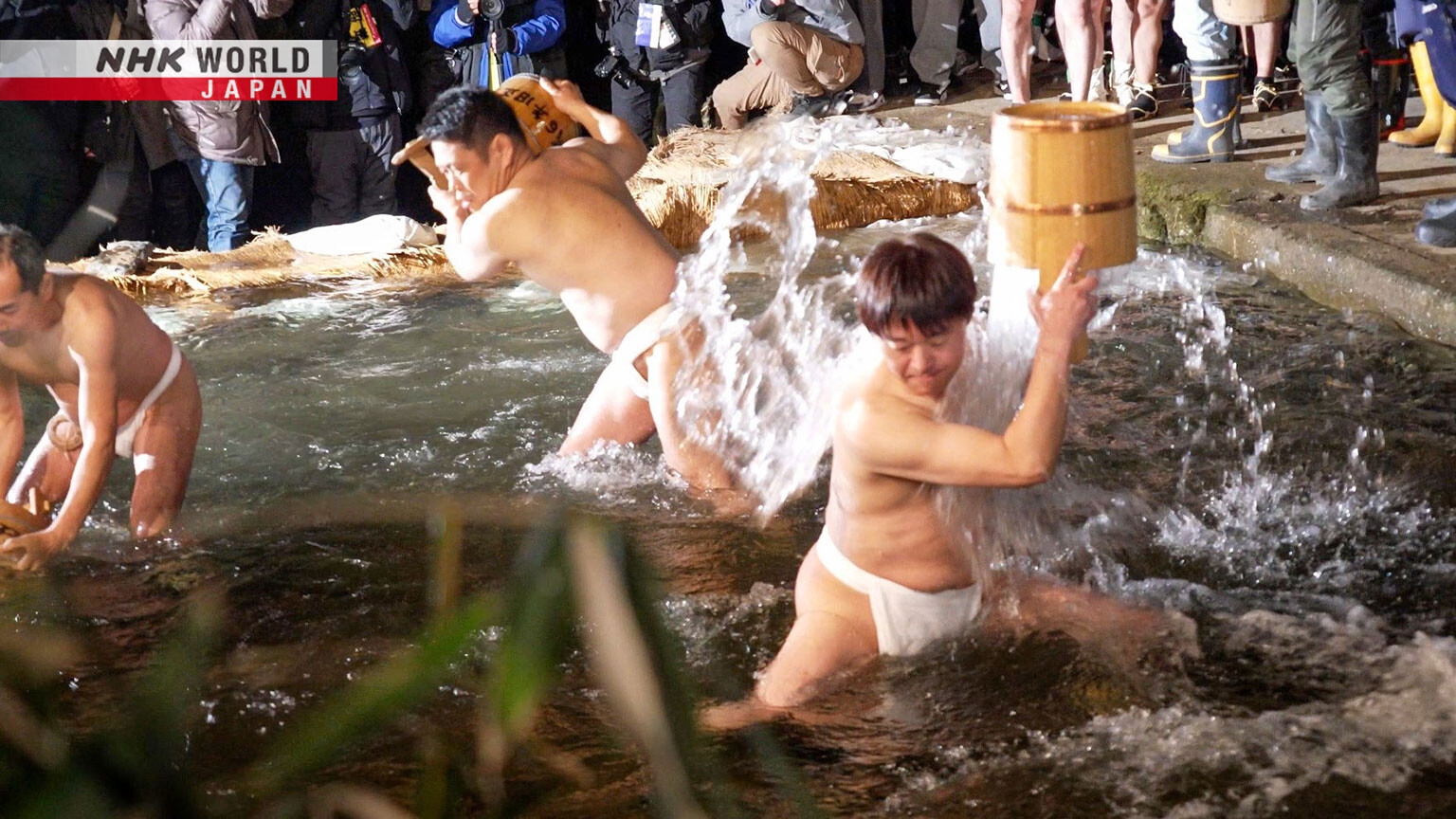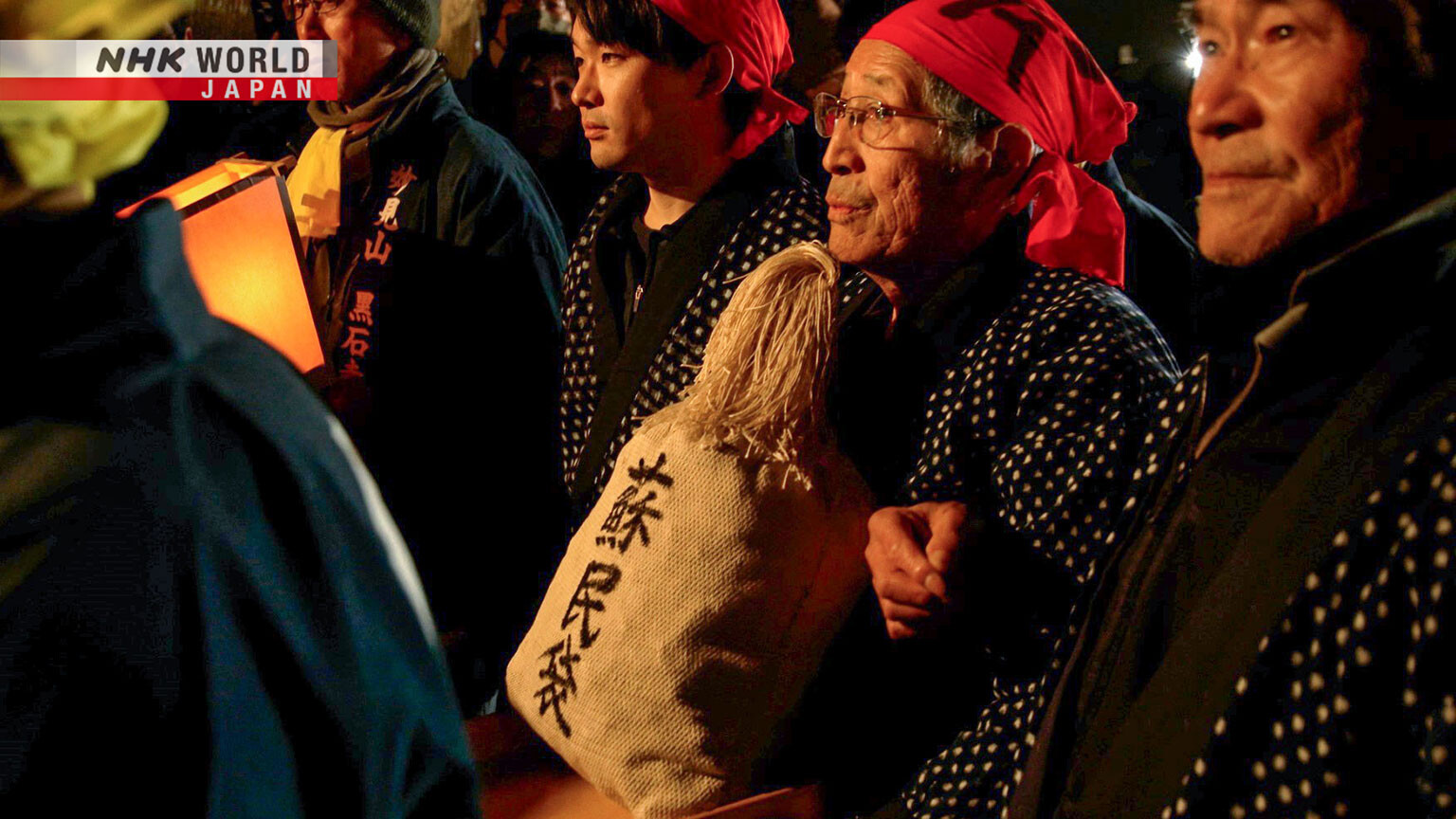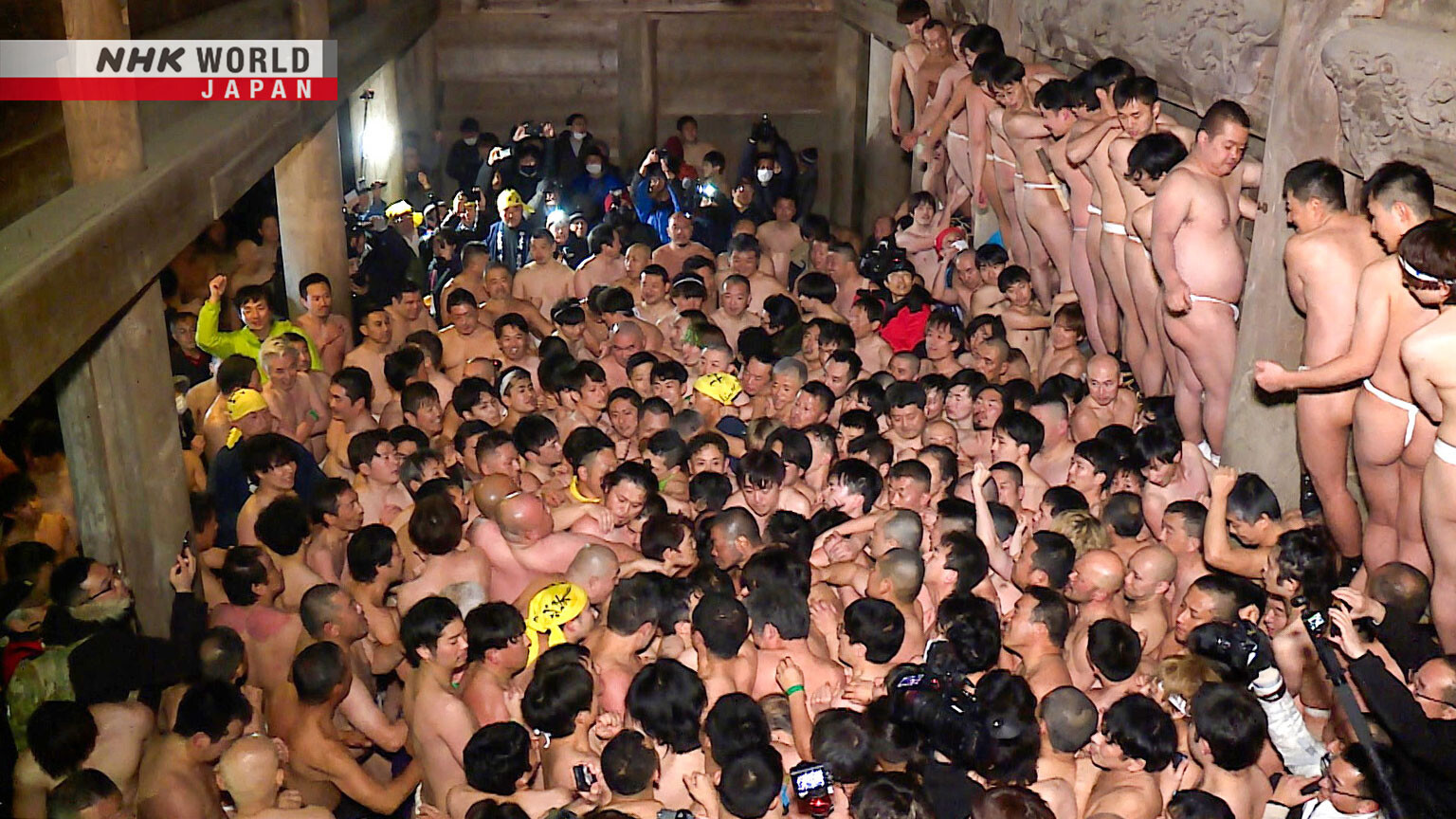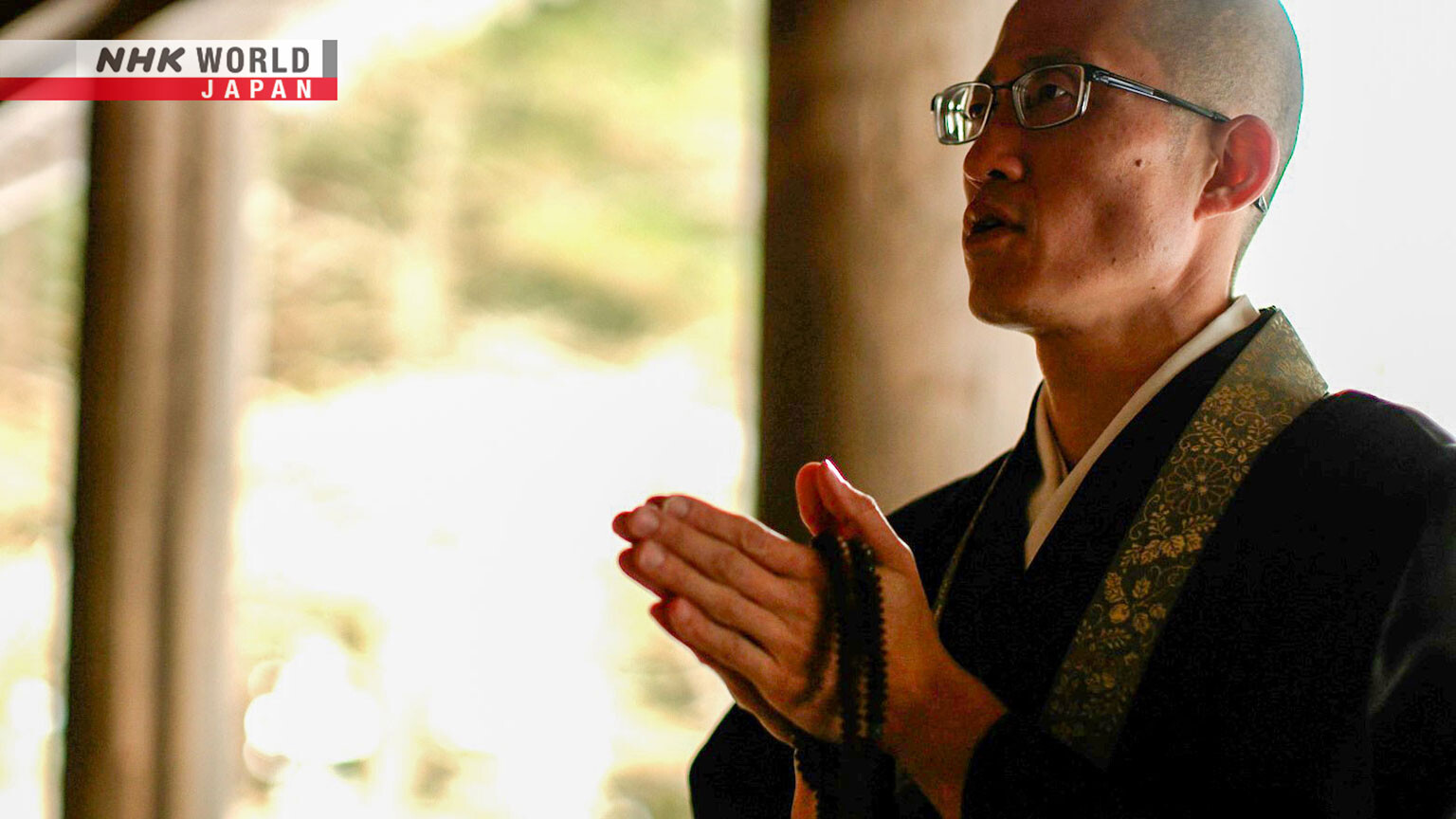This year saw the end of Sominsai, a unique festival in which loinclothed men plunge into freezing water, are enveloped in smoke, and jostle through the night to grasp a lucky sack as a form of prayer.




Transcript
Iwate Prefecture, in Japan's northeast.
The region is known for its freezing winters.
But February is the month for a festival said to date back over a thousand years.
The festival begins with near naked men entering a freezing river to purify body and soul.
This is followed by another purification ritual, this time by fire.
Pushing themselves to the limit, they pray to the Buddha for a bountiful harvest and good health.
The climax of the festival is a battle to win a hemp bag called the Somin Sack
that will bring good luck for the coming year.
Clad only in loincloths, the men give their all to try and grasp the lucky sack.
But in December 2023, it was announced that the next festival would be the last.
The news was met with mixed feelings.
Honestly, I want it to go on.
I look forward to seeing the same faces every year.
It's a constant in our lives.
The Sominsai shows us the way toward purity and enlightenment.
So, it's frustrating.
Why does the festival have to end?
Fixating on the conventions makes us forget.
It's a good idea to stop and reflect on what the festival is about.
We explore the meaning behind the purification rituals,
as the curtain falls on this 1,000-year-old festival.
To the Kokusekiji Sominsai!
The festival takes place at Kokusekiji, an ancient temple in the Kuroishi District of Oshu.
It's the end, so let's give it our best.
But be careful. Okay then, let's begin.
I'm helping build a shelter.
Here we'll change, rest, and warm up.
The preparation is part of the Sominsai.
It's sad to think we won't be able to work together like this.
About 60 people, mostly locals, belong to the Youth Division of the Kokusekiji Sominsai Preservation Association.
Many of them have taken part in the battle for the Somin Sack.
They're also in charge of festival preparations.
They build shelters for the participants to rest, along with a makeshift cafeteria.
The group plays an integral role in the Sominsai.
The festival was suspended during the pandemic,
so this is the first time in four years that it's being held at a large scale.
It's one of the five toughest things I've ever done.
I was an amateur boxer until I was forty.
The Sominsai gives me a similar sense of accomplishment.
I have no idea.
That's probably why it's continued for 1,200 years.
Why does the festival demand so much from its participants?
This is the main hall of Kokusekiji.
It's dedicated to the Yakushi Nyorai, the Buddha of Healing.
Sominsai is dedicated to the Buddha.
The Yakushi Nyorai has long been revered in this region as the Buddha of healing and medicine.
By taking on extreme challenges and pushing themselves to the limit,
the participants purify body and soul to pray to the Yakushi Nyorai.
It's this desire that drives the 1,000-year-old festival.
There's meaning in holding it in the coldest season.
We bare body and soul to carry out the purification rituals.
Hey, Boss. Time for lunch.
Let's break for lunch.
You have to experience it to appreciate it.
It's really tough.
Five years ago, I took part in the Sominsai.
It was a life-changing experience.
As I donned the loincloth, I braced myself for what was to come.
Let's give it our all!
The purification rituals began with sake.
Jasso! Jasso! Jasso! Jasso!
With naked prayer, the all-night festival got rolling.
This year, there were 200 participants from around Japan, though most were locals.
It was minus 8 degrees Celsius.
We shouted to maintain our courage.
Huddle up closer. It's warmer that way.
I was not me.
I was somewhere else.
Alone, we humans are weak creatures.
It's when we get together that we are capable of extraordinary things.
I needed to do the screaming but the smoke I can't breathe.
That was near death experience.
The Somin Sack was brought out in the dead of night.
The battle was on to grasp it and receive the blessings of the Yakushi Nyorai.
Inside the Somin Sack are wooden charms called komagi,
which are distributed to those who have gathered at the festival to share the blessings of the Buddha.
The struggle for the sack went on for over an hour.
By the time it was over, we were all on the verge of collapse.
Whoever isn't touching the sack, get out!
The man left holding onto the Somin Sack until the very end is declared the Torinushi, the winner.
Their family will receive an even greater blessing and enjoy a bountiful harvest and good health.
Well done.
Thank you.
You had it for a moment, didn't you?
I was actually holding onto it the whole time. I just let go at the end there.
It's kind of a metaphor for life.
I remembered before I was born.
I felt like a sperm.
I feel like this is what it means to fight for your life.
This life, the fact that we're here, it's a total miracle.
No matter what happens, good, bad, whatever...
Standing bare shoulder to bare shoulder through disaster, our common prayer was shared.
It felt like the true essence of the Sominsai.
Good luck to you. All the best.
Five years after I took part, the chief priest of Kokusekiji decided it was time to end the Sominsai.
The Sominsai relies on the community effort, especially the parishioners.
But the population is aging, making preparations difficult.
That's why I decided that this year's Sominsai would be the last.
Besides providing financial backing, the parishioners support the everyday workings of the temple,
helping to organize events and ceremonies.
Kokusekiji relies on the support of just a dozen or so parishioner families.
Japan's aging population crisis has affected the temple's district of Kuroishi.
Of 968 residents, nearly half are 65 or older.
The families prepare the mochi, the sacred straw ropes, the Somin Sack, etc.
The roles played by each family have been handed down through the ages.
The preparations are part of the ritual.
From making tools to performing ceremonies and rituals -
the roles played by each parishioner family have been handed down through generations.
The Otategi is a wooden structure that serves as a guidepost for the Buddha and the deities arriving for the festival.
The parishioners are responsible for constructing it.
The person who inherited the technique for tying the ropes has passed away.
So for over a decade, the same ropes have had to be reused.
These preparations hold deep religious significance,
but it has become increasingly difficult to carry them out.
The chief priest felt it was time to reflect on the origins of the festival.
That's why he decided to stop it.
Hatanaka Akihiro researches Japanese festivals.
He understands why this difficult decision was made.
These charms are placed inside the Somin Sack.
The parishioners are responsible for making them.
They're essential to the festival.
Since ancient times, Japan has experienced more than its share of natural disasters.
To survive and thrive, people offered prayers to the deities and the Buddha in the form of festivals
to seek protection from disasters and disease and enjoy a bountiful harvest.
The Kuroishi district has been hit hard by natural disasters such as flooding, heavy snow, and crop-damaging cold.
People tried to overcome these hardships through cooperation and prayer.
I believe the Chief Priest is taking a proactive approach.
He is hoping to keep the spiritual significance of the festival alive.
We need to think about why the festival has been held for so long.
What matters most is the belief in the Buddha of Healing.
Ishikawa Mitsuo, a member of the Preservation Association's Youth Division,
helped me through the Sominsai five years ago.
My grandson.
Ishikawa isn't a parishioner, but for generations,
his family has taken part in both the battle for the Somin Sack and festival preparations.
If you live in Kuroishi, it's unavoidable.
Sure as night follows day!
Building the bonfire is a part of the festival.
I watched my father doing it, so I started doing it, too.
I'm following in his footsteps.
Light it up!
The construction of the sacred bonfire has long been the responsibility of the Youth Division,
with Mitsuo's father, Tadamitsu, playing a central role.
This year, there will be no climbing of the bonfire.
Instead, they're building a smaller wooden scaffold.
I'm scared.
You can do it. Stand up!
I hope he'll inherit my passion and take on challenges.
And that he'll carry on the tradition even in a different form.
Good evening.
Come on in.
This is the Somin Sack.
The komagi wooden charms are taken out and distributed.
This happens during the scramble for the sack.
The last man holding the mouth of the sack is proclaimed the winner.
I won the year he was born.
I'm proud he was able to do what I failed to achieve.
That goes for everything, not just the festival.
You'll make me cry!
The symbol of the Sominsai, the Somin Sack, comes from the legend of Somin Shorai
from Japan's Nara Period over 1,000 years ago.
Somin Shorai was a kind and generous man who helped others despite his own poverty.
The deities and the Buddha recognized his piety and promised lasting prosperity for his family and descendants.
I thought the festival would go on forever.
We suggested conducting it on a smaller scale.
But the Chief Priest said he had no choice but to end it.
I'm sad. It's frustrating.
The festival has been held for ages.
It's a family tradition.
I'm sad, but it can't be helped.
You like the festival?
Yes.
Why?
It's fun.
Just fun.
We love the festival.
The short stakes go here, under the sheet.
Youth Division member Sasaki Mitsuhito has supported the Sominsai for 20 years.
This is where the food will be prepared.
I won't strip down.
I'll stick to organizing the water and fire purification rituals.
He says he will focus on playing a backstage role in the final Sominsai.
This scarf was woven by an artist who wove the Somin Sacks until 2011.
Ogawa Kumiko passed in the Great East Japan Earthquake.
They wanted me to have this to remember her by.
Ogawa Kumiko was a dye and weaving artist.
She remains unaccounted for since the earthquake.
Ogawa was commissioned by Kokusekiji to weave the hemp fabric used to make the Somin Sack.
I'll take this with me to the Sominsai.
She'll be with me in spirit.
I'm actually trying to make a Somin Sack myself.
During the festival, the sack is cut up.
The charms will be distributed. Nothing will remain.
I want to leave something tangible for the next generation.
I want to pass it on.
Eight days before the festival, Ishikawa begins a purification ritual
in which he abstains from eating meat, fish, eggs, and other animal protein,
along with strongly scented foods like chives and garlic.
His entire family joins him.
This is yummy.
We avoid eating certain foods to cleanse our bodies.
It also reflects our commitment to becoming a better person.
Five years ago, I felt a transformation in both mind and body after changing what I ate.
My mind was clear and my body felt light.
The Sominsai started out as a way to help those who were suffering.
It offered salvation when there was no medicine.
Embracing good eating habits and cleanliness helped prevent illness.
It was a form of salvation.
Good morning.
All this work for just one night and then to dismantle it.
Such a shame.
It's so exciting to see it all come together after 4 years.
Taste the shiitake!
The food served here is strictly vegetarian so that everyone can enjoy it.
Shiitake mushrooms make for a flavorful broth to have with buckwheat noodles, konnyaku, and more.
The late Ogawa shares my excitement at opening the hall.
I wish we could continue it.
I still can't believe this is the end.
My personal shrine.
I'm making konnyaku sticks.
I'll be with my dad.
Are you bathing in the river?
No!
Try it.
No way!
Welcome.
Ramen please.
Coming up. With pork?
Haha, good one!
It's great to see familiar faces for the first time in 3 years.
The Sominsai was in danger of ending after the war.
That's why my father's generation set up the Youth Division.
They were in their 20s.
They wanted to preserve and keep the festival alive.
We all feel that way.
The excitement will build up as it gets dark.
On the day of the festival,
visitors to the temple are served plain water drawn from the mountain and kept at a boil.
Those who drink this "medicinal water" will be blessed by the Yakushi Nyorai.
It's supposed to be scalding hot, but I don't feel it.
Strange, isn't it?
I'm going to drink it at home.
As many as 7,000 people gather for the final Sominsai - far more than usual.
Security is tightened to deal with the large crowd.
Participants write their wishes and prayers on square lanterns, which they carry during the festival.
I wanted to witness the end of its long history.
I knew this would be my last chance to take part.
Drink up!
Who wants more?
Let's go!
To the Kokusekiji Sominsai!
Let's go!
At the head of the procession is Kikuchi Toshiaki, the fifth director of the Youth Division.
The character "Kizuna," meaning bond or connection,
is a prayer for those who died in the Great East Japan Earthquake.
The naked prayers commence with the water purification ritual.
As they purify themselves in the river,
the participants walk around the hall three times, offering prayers for an hour and a half.
He stripped down and tagged along.
Were you scared? Cold?
I was scared.
He'll gradually learn the traditions.
Hopefully, his generation will be able to revive the Sominsai.
I'm going to go all out and win the Somin Sack.
You can do it, Dad!
You bet!
The cafeteria is bustling with activity.
It's a chance to meet up with people once a year.
It's a constant in our lives.
I prepare for the Sominsai while praying for everyone's safety.
I like being the organizer.
The Chief Priest burns sacred wood before the altar to infuse the Somin Sack with the blessings of the Yakushi Nyorai.
Mochi is tossed towards the loinclothed men to call for a year of good luck.
Hang in there!
Now for the climax of the festival.
The Somin Sack is tossed into the crowd of naked men.
The battle begins.
There are 270 participants, double the number of previous festivals.
It's a battle to win the most luck of all.
No pushing!
Ishikawa is close to the sack.
Hanging in next to him is Kikuchi, the Director of the Youth Division.
The Somin Sack makes its way outside the main hall.
The festival is drawing to a close.
The final Torinushi is about to be announced.
It's Kikuchi, the Director of the Youth Division.
The Director of the Youth Division!
I'm happy that one of us won the sack.
We all feel as if we've won it with him.
Make way.
Thanks.
Winner Kikuchi receives his prize:
60 kilograms of locally grown rice.
Congratulations!
We're all working together to pass it on to the next generation.
Hopefully, we can revive it by the time I'm a grandfather.
A 1,000-year-old festival has come to an end.
It looks like summer, doesn't it? It's really warm.
Look! I found a crab.
In the river.
The men who fought the battle of their lives are embracing the unexpected spring-like weather.
The future of the Sominsai is now in the hands of the next generation.
It's over.
I felt the spirit of Ogawa with me. I think she was happy that it ended safely.
My desire to keep the Sominsai alive is stronger than ever.
I asked her to help me pass it on.
I hadn't expected such a huge response.
Many people have expressed their desire to continue the festival.
I want to discuss with them what they want to preserve and how.
We need to focus on what really counts.
First meat.
It's been a week.
I feel emotional.
You're crying again.
You haven't stopped.
Poor thing.
The Youth Division will continue, even after the Sominsai.
I'll be passing on the reins to Ishikawa Mitsuo. He'll make a great director.
I know you'll give him your full support.
Let's keep the Sominsai going.
Good job!
You did well.
Let's keep it up.
Maybe the festival will take a new shape.
But the bond between the people and the heart behind the prayer will never die.
I look forward to the next stage of this tradition.